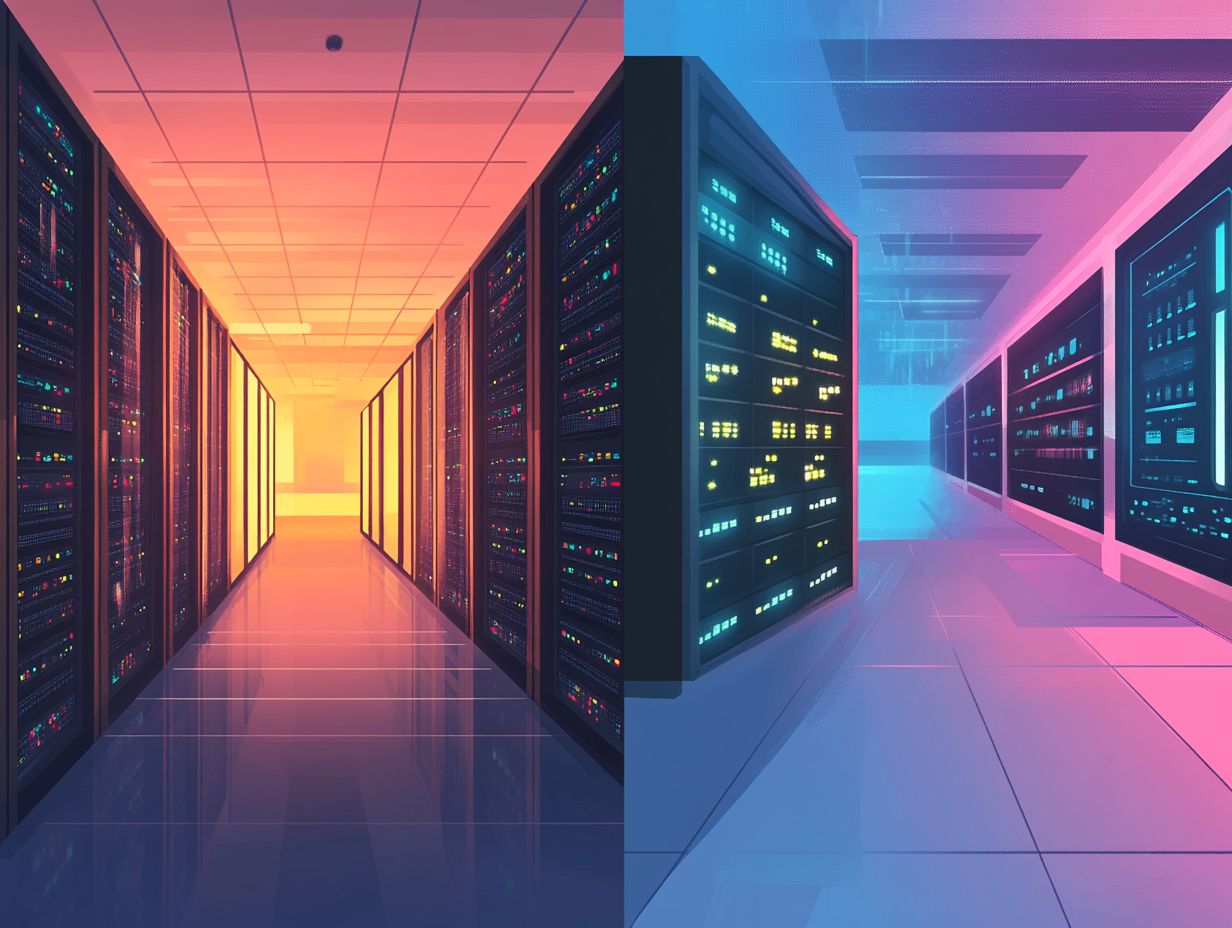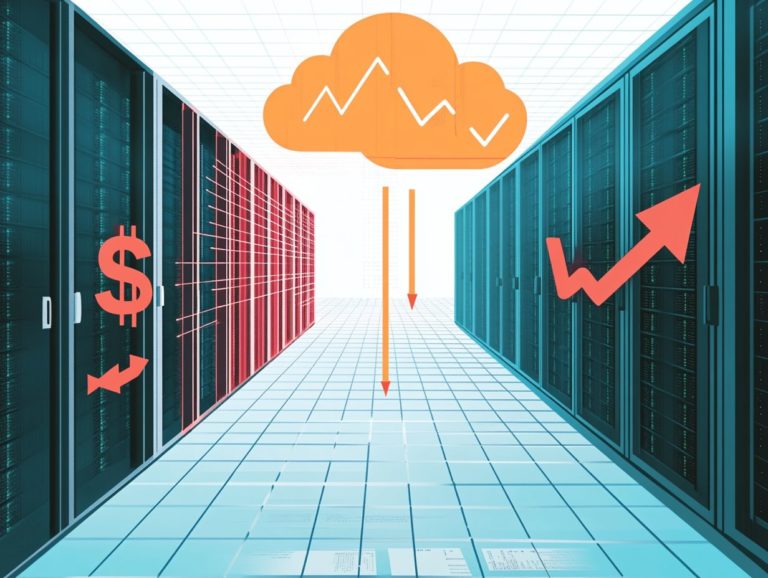Hybrid Cloud vs. Traditional IT: A Comparison
In today’s fast-paced digital landscape, you face a pivotal decision: to embrace hybrid cloud solutions or to remain anchored to traditional IT infrastructures.
Each option presents its own distinct definitions, benefits, and challenges. This article delves into the essential characteristics of both hybrid cloud and traditional IT, shedding light on their respective advantages for your organization.
Cost considerations, security features, and scalability will also be explored, providing a comprehensive view of what each model offers. By the end, you’ll be ready to make a choice that could transform your business!
Contents
- Key Takeaways:
- Understanding Hybrid Cloud and Traditional IT
- Benefits of Hybrid Cloud
- Benefits of Traditional IT
- Comparison of Costs
- Security Considerations
- Scalability and Flexibility
- Frequently Asked Questions
- What is the difference between hybrid cloud and traditional IT?
- What are the benefits of using hybrid cloud over traditional IT?
- In terms of security, which is more reliable: hybrid cloud or traditional IT?
- What are the limitations of hybrid cloud compared to traditional IT?
- Can a company switch from traditional IT to hybrid cloud?
- Which is More Cost-Effective: Hybrid Cloud or Traditional IT?
Key Takeaways:

Hybrid Cloud offers a flexible and scalable solution for businesses, allowing them to combine the benefits of both public and private clouds.
Traditional IT may be a cost-effective option for organizations with predictable workloads and specific security requirements.
When comparing costs and security features, businesses should carefully assess their needs and choose the cloud solution that best fits their requirements.
Understanding Hybrid Cloud and Traditional IT
Hybrid Cloud and Traditional IT stand as two distinct models in the computing landscape, each tailored to meet specific business needs. Understanding the differences between IaaS vs. traditional IT infrastructure can help businesses make informed decisions.
The Hybrid Cloud merges the flexibility of cloud services think AWS or Google Cloud Platform with the reliability of traditional hosting, incorporating dedicated servers and VPS hosting. This combination allows organizations to optimize performance and cost.
On the other hand, Traditional IT leans heavily on physical servers located at your site. While this may restrict scalability and flexibility, it provides an alternative approach to cost efficiency and resource allocation that some businesses may still find appealing.
Definitions and Key Characteristics
Hybrid Cloud represents a sophisticated computing environment that seamlessly merges both private and public cloud infrastructures. This approach allows you to harness the advantages of both setups, while Traditional IT focuses on on-premises systems that rely on dedicated servers and conventional hosting solutions.
This dual approach not only grants you flexibility in customizing your infrastructure but also optimizes energy consumption, as resources can be allocated more efficiently. While Traditional IT may offer a dependable foundation with complete control over your data and applications, it often grapples with challenges such as elevated energy costs and reduced agility compared to the scalable nature of Hybrid Cloud.
In critical areas like data recovery and security protocols, both models employ distinct strategies to minimize service disruptions. Hybrid Cloud leverages redundant systems across its frameworks to enhance recovery options, while Traditional IT depends on established disaster recovery protocols for reliability.
Each model must address potential service interruptions, striking a balance between performance and security to meet the ever-evolving demands of enterprises.
Benefits of Hybrid Cloud
The Hybrid Cloud model presents a wealth of advantages for your business, ranging from better scalability to lower costs, making it a smart choice for businesses dealing with high traffic and dynamic workloads.
By seamlessly integrating cloud services with your traditional IT infrastructure, you can optimize resource allocation and attain greater redundancy, effectively addressing performance challenges during peak periods.
This level of flexibility gives you the power to adapt to shifting demands without incurring the significant expenses tied to dedicated servers.
Advantages for Businesses and Organizations
Using Hybrid Cloud solutions, businesses gain easy access and greater control. This empowers teams to manage IT resources effectively and collaborate seamlessly.
This approach streamlines IT management and integrates existing infrastructure with new technology. By blending public and private cloud services, you protect sensitive data and enjoy the scalability of public clouds.
Collaborative tools enhance real-time communication, speeding up project timelines and boosting productivity. This mix of flexibility and security optimizes your cloud strategies, helping your business adapt to changing demands without sacrificing performance.
Benefits of Traditional IT

Traditional IT systems provide a solid foundation with dedicated servers and on-premises solutions. They focus heavily on security and data privacy.
This makes them ideal for organizations with strict compliance needs and specific operational requirements. Reliability and a clear performance-to-price ratio make traditional IT appealing.
With traditional IT, your data and applications remain accessible, which minimizes downtime and builds trust among your teams. Predictable performance helps you plan resources and scale operations effectively.
Maintenance is straightforward for IT teams, allowing them to implement updates and resolve issues easily. This support from knowledgeable teams keeps your systems running optimally.
These factors create a stable environment, letting you concentrate on your core goals without technical distractions.
Comparison of Costs
When comparing costs of Hybrid Cloud and Traditional IT, consider initial investments, ongoing expenses, and overall efficiency. Analyzing your cost structure helps identify which model best suits your financial needs.
The Hybrid Cloud may have lower upfront costs, but it can lead to variable expenses based on usage. On the other hand, Traditional IT usually requires higher initial investments but can stabilize costs over time.
Cost Considerations for Hybrid Cloud and Traditional IT
Cost considerations for Hybrid Cloud focus on operational expenses related to scalability and usage patterns. Traditional IT typically requires a fixed budgeting approach due to its hardware and maintenance costs.
With a Hybrid Cloud, you can adjust resources based on demand, leading to savings during peak and off-peak periods. Watch out for potential data transfer fees and extra configuration costs.
Traditional IT requires commitment to on-premises infrastructure, including upfront hardware, software licenses, and ongoing support. These costs can be significant in today s fast-paced digital landscape.
Understanding how these approaches affect your overall expenses is key to optimizing your IT budget.
Security Considerations
Security for Hybrid Cloud and Traditional IT differs significantly. Evaluate your security protocols, data privacy measures, and regulatory compliance closely.
This evaluation is vital for protecting your operations from threats and avoiding service disruptions.
Security Features and Risks for Hybrid Cloud and Traditional IT

Both Hybrid Cloud and Traditional IT environments present distinct security features and risks. Implementing strong security measures is essential to safeguard data privacy and ensure compliance with standards.
The key difference between these two setups often lies in how they tackle various security challenges. In a Hybrid Cloud configuration, for example, sensitive data might be stored off-premises, raising the stakes regarding vulnerability to external threats. Traditional IT systems, while offering more controlled environments, can struggle with scalability and innovation.
As you navigate these complexities, it is crucial to stay vigilant about compliance issues like GDPR and HIPAA. These regulations demand stringent measures to maintain data sovereignty, meaning that data is subject to the laws of the location where it is stored. This highlights the necessity for comprehensive security strategies.
Regular audits, encryption protocols, and employee training are essential steps to mitigate risks and protect your invaluable information within both frameworks.
Scalability and Flexibility
Scalability and flexibility are vital considerations when deciding between Hybrid Cloud and Traditional IT solutions.
These factors significantly influence how you allocate resources and manage performance challenges during fluctuating workloads.
Scalability and Flexibility for Hybrid Cloud and Traditional IT
Hybrid Cloud stands out for its remarkable scalability and flexibility, enabling you to adjust resources in response to traffic demands. In contrast, Traditional IT provides a more stable environment but lacks the adaptability due to its fixed infrastructures.
In today s dynamic business landscape, the ability to react swiftly to changing market conditions is crucial. This is where Hybrid Cloud excels. For instance, if you re running an e-commerce platform that sees a surge in traffic during the holiday season, you can easily ramp up your cloud resources while keeping essential services on-premises.
Conversely, a manufacturing firm may prefer Traditional IT for its sensitive operations, where stability and compliance take precedence. These contrasting strategies empower you to harness both efficiency and reliability, ensuring your business remains competitive and responsive to customer needs without compromising performance.
Frequently Asked Questions
What is the difference between hybrid cloud and traditional IT?
The main difference between hybrid cloud and traditional IT is how they handle data and applications. In traditional IT, all data and applications are stored and managed on-premises, while hybrid cloud combines both on-premises and off-premises resources.
What are the benefits of using hybrid cloud over traditional IT?

Hybrid cloud offers several advantages compared to traditional IT, such as increased flexibility and scalability, cost-effectiveness, and improved disaster recovery. It also allows for better resource utilization and easier management of workloads.
In terms of security, which is more reliable: hybrid cloud or traditional IT?
Both hybrid cloud and traditional IT have their own security measures. However, hybrid cloud may offer better security since data is stored in both on-premises and off-premises locations, reducing the risk of losing all data in case of a security breach.
What are the limitations of hybrid cloud compared to traditional IT?
Hybrid cloud may have limitations regarding compatibility and integration with legacy systems. It also requires a more complex infrastructure and may incur higher maintenance costs compared to traditional IT.
Can a company switch from traditional IT to hybrid cloud?
Yes, a company can switch from traditional IT to hybrid cloud, but it requires careful planning and implementation. The process may involve migrating data and applications to the cloud, reconfiguring the IT infrastructure, and training employees on new systems.
Don’t miss out on the chance to enhance your operations! Explore our services to find the right cloud solution for your needs today!
Which is More Cost-Effective: Hybrid Cloud or Traditional IT?
In the long run, hybrid cloud is often more cost-effective than traditional IT. Hybrid cloud combines public and private cloud resources, offering flexibility and efficiency.
While initial setup and maintenance costs may be higher, the flexibility and scalability can lead to significant savings over time. Investing in hybrid cloud solutions can prepare your business for future growth!






